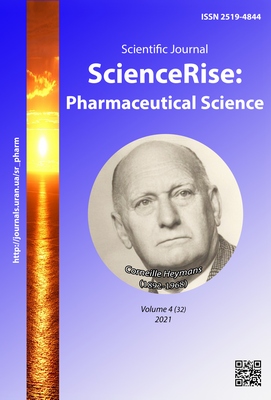Application of approach for development of hptlc identification and quantification methods for determination of phenolic compounds and terpenoids of several Thymus L. species
DOI:
https://doi.org/10.15587/2519-4852.2021.238806Keywords:
high-performance thin-layer chromatography, Thymus, standardization, identification, quantification, flavonoids, essential oils, triterpenoidsAbstract
The aim of this work was to improve the approaches for standardization of Thymus L. species by development of HPTLC identification of phenolic compounds (flavonoids and phenylpropanoids) and terpenoids (essential oils and triterpenoids) and quantitative determination of rosmarinic acid and flavonoids for six Thymus L. species of Ukraine flora, as well as determination of chromatographic profiles of Thymus L. species’ extracts obtained using different extraction methods.
Materials and methods. Objects were: samples of dry herb of Th.serpyllum, Th.vulgaris, Th.Marschallianus, Th.Pallasianus, Th.calcareus, and Th.moldavicus of Ukraine origin collected in 2019-2021 years or acquired commercially on Ukraine market. Instruments: CAMAG HPTLC Herbal System, visionCats 2.5. The analytical grade reagents were used. Reference substances were purchased from Extrasynthese, Sigma Aldrich. Chromatography was performed on HPTLC plates Si 60 F254, Merck according to the developed methods.
Results. A new approach for quality control of different Thymus L. species of Ukraine flora included the development of HPTLC methods for identification of main groups of bioactive substances of these species, such as flavonoids and phenylpropanoids, essential oils, triterpenoids; development of quantification method of rosmarinic acid and assay of total flavonoids, expressed as luteolin-7-O-glucoside. The characteristic HPTLC fingerprints of six Thymus L. species in three mobile phases of different polarities that cover a wide range of bioactive substances were established. The content of rosmarinic acid in different Thymus L. species samples was in the range of 0,11-0,72 %: Th.moldavicus – 0,11 %; Th.Marschallianus – 0,19-0,27 %; Th.serpyllum – 0,38 %; Th.vulgaris – 0,51 %; Th.calcareus – 0,56 %; T.Pallasianus – 0,72 %. The total flavonoids content, expressed as luteolin-7-O-glucoside, was in the range of 0,8-2,72 %: Th.moldavicus – 0,8 %; Th.serpyllum – 0,87 %; Th.vulgaris – 1,06 %; Th.Pallasianus – 1,28 %; Th.Marschallianus – 1,89 %; Th.calcareus – 2,72 %.
Conclusions. The proposed scientific approach for quality evaluation of Thymus L. species using HPTLC allows to determine comprehensive information of chemical composition and content of active substances of multiple samples in parallel, in a cost and time-efficient manner
References
- Dobrochaeva, D. N., Kotov, M. I., Prokudin, Iu. N. et. al. (1987). Opredelitel vysshikh rastenii Ukrainy. Kyiv: Naukova dumka, 548.
- Shishkin, B. K. (Ed.) (1954). Flora SSSR. Vol. XXI. Moscow: AN SSSR, 704.
- Starchak, Iu. A. (2016). Farmakognosticheskoe izuchenie rastenii roda timian (Thymus L.) kak perspektivnogo istochnika polucheniia fitopreparatov. Kursk, 472.
- Ivashin, D. S., Katina, Z. F., Rybachuk, I. Z., Ivanov, V. S., Butenko, L. T. (1974). Lekarstvennye rasteniia Ukrainy. Spravochnik dlia sborschika i zagotovitelia. Kyiv: Urozhai, 360.
- European Pharmacopoeia 9.0. (2016). Available at: https://www.coe.int/en/web/portal/-/the-9th-edition-european-pharmacopoeia-maintaining-high-quality-standards-in-a-dynamic-global-environment
- Derzhavna farmakopeia Ukrainy (2.0). (2015). Kharkiv: DP «Naukovo-ekspertnyi farmakopeinyi tsentr.
- Derzhavna farmakopeia Ukrainy Dop. 2 (2nd ed.). (2018). Kharkiv: DP «Naukovo-ekspertnyi farmakopeinyi tsentr.
- Caсigueral, S., Frommenwiler, D., Reich, E., Roser, V. (2018). High performance thin-layer chromatography (HPTLC) in the quality control of herbal products. Recent Advances in Pharmaceutical Sciences VIII, 119–136.
- Do, T. K. T., Clark, K., Christen, P., Reich, E. (2020). Quality assessment of Sclerocarya birrea leaves and leaves products from Burkina Faso based on fingerprinting using HPTLC. JPC – Journal of Planar Chromatography – Modern TLC, 33 (5), 439–448. doi: http://doi.org/10.1007/s00764-020-00058-5
- Russia State Pharmacopoeia 13 (XIII) online. Available at: https://pharmacopoeia.ru/en/gosudarstvennaya-farmakopeya-xiii-online-gf-13-online/
- Marakhova, A. I. (2016). Unifikatsiia fiziko-khimicheskikh metodov analiza lekarstvennogo rastitelnogo syria i kompleksnykh preparatov na rastitelnoi osnove. Moscow, 313.
- Nowak, R., Wójciak-Kosior, M., Sowa, I., Sokołowska-Krzaczek, A., Pietrzak, W., Szczodra, A., Kocjan, R. (2013). HPTLC-densitometry determination of triterpenic acids in Origanum vulgare, Rosmarinus officinalis and Syzygium aromaticum. Acta poloniae pharmaceutica, 70 (3), 413–418.
- Ayeleso, T., Matumba, M., Mukwevho, E. (2017). Oleanolic Acid and Its Derivatives: Biological Activities and Therapeutic Potential in Chronic Diseases. Molecules, 22 (11), 1915. doi: http://doi.org/10.3390/molecules22111915
- A pipeline for the discovery, sustainable production and commercial utilisation of known and novel high-value triterpenes with new or superior biological activities (2018). Available at: https://cordis.europa.eu/project/id/613692/reporting
- Khokhlova, K. O., Vyshnevska, L. I., Zdoryk, O. A., Kapustianskyi, I. Yu. (2021). Pat. No. 146608 UA. Sposib kilkisnoho vyznachennia kysloty rozmarynovoi metodom vysokoefektyvnoi tonkosharovoi khromatohrafii. MPK: G01N 33/02 (2006.01). No. u202006908; declareted: 28.10.2020; published: 04.03.2021, Bul. No. 9.
- Pharmeuropa Archives (2012). Texts for comment 24.4. EDQM. Available at: https://pharmeuropa.edqm.eu/app/Archives/content/Archives-37164/Pharmeuropa_24.04E.pdf
Downloads
Published
How to Cite
Issue
Section
License
Copyright (c) 2021 Kateryna Khokhlova, Liliia Vyshnevska, Oleksandr Zdoryk, Olga Filatova

This work is licensed under a Creative Commons Attribution 4.0 International License.
Our journal abides by the Creative Commons CC BY copyright rights and permissions for open access journals.








